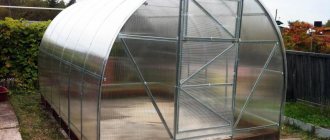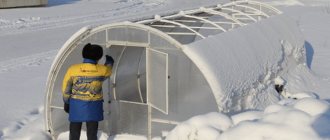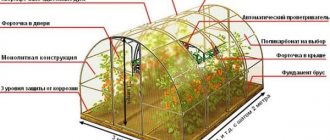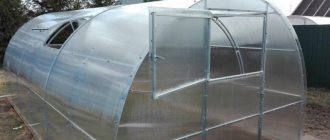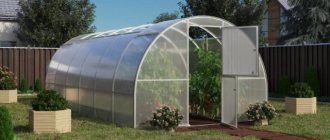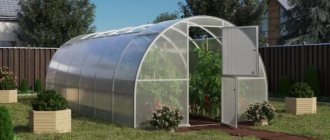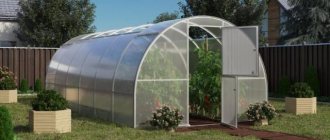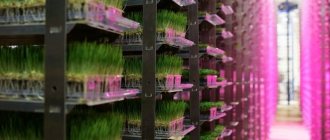Having decided to install a greenhouse at their dacha, many gardeners prefer to purchase ready-made polycarbonate greenhouses. Manufacturers convince that their designs are strong, reliable and serve faithfully for many years. But, unfortunately, this does not always happen. Choosing a good greenhouse is not as easy as it seems at first glance. In addition, assembling a polycarbonate greenhouse also has its own specifics and requires certain knowledge.
#video_insert_place
They are comfortable for the manufacturer: a polycarbonate sheet 6 m long “lays” on an arch 1.9 m high and 3.8 m wide. At first glance, everything is fine: both the height and width are sufficient, and polycarbonate is used completely correctly. But working in a greenhouse of this size is not entirely comfortable. The beds, usually made around the perimeter of the building, turn out to be very wide and very awkward for weeding, watering, and tying up plants. In addition, the beds in such greenhouses cannot be very high, only level with the ground.
#video_insert_place
Any construction, even fencing, begins with the installation of a foundation. Our greenhouse is no exception. The foundation can be made in several ways and materials. In most cases, gardeners choose concrete, stone, and brick in construction. You probably just need to use the material that you have available.
Arches are installed on the harness. In order for the structure to become rigid and not collapse under the snow in winter, the arches will need to be tied with transverse ties. Unfortunately, arches can only be bent using special equipment, and here you have two options: order arched elements from a special company or change the shape of the greenhouse, for example, you can make it in the form of a house.
Specifics of the greenhouse “Dachnitsa”
“Dachnitsa” has three varieties, which are united by a common design solution. Each type is characterized by an arched shape, cellular polycarbonate as a cladding and a collapsible frame made of galvanized profile.
Such structures are also equipped with two doors and two windows for ventilation.
Advantages of the greenhouse "Dachnitsa"
All such agricultural buildings have a number of advantages. They:
- Easy to install. All elements require cutting, welding and processing. The buyer only has to deliver them to his site, connect them using the “pipe to pipe” technique, bolt them and sheathe them. Anyone can handle this kind of work – no special skills or special knowledge are needed.
- Durable. Each part is galvanized, all seams are subject to additional processing and painting. Therefore, the service life is determined exclusively by the polycarbonate coating.
- Reliable. They are not afraid of sharp gusts of wind and an abundance of snow.
- They are characterized by relatively low weight. Replacing heavy glass sheets with cellular polycarbonate helps reduce the weight of the entire structure, which simplifies its transportation, installation and disassembly.
- Can be installed without a foundation. Such buildings can be attached directly to the ground or to a beam knocked into a box.
- They have excellent strength. The sheathing material perfectly withstands large hail, fallen branches and even thrown stones.
- Financially accessible. The low price is due to factory production and a well-developed technological process.
Manufacturing
Before you start on your own summer cottage, you need to prepare its project. It is necessary not only to indicate all design parameters and connection nodes, but also the material chosen for the work. In this case, it is necessary to take into account all the garden tricks of the greenhouse in order to achieve maximum effect at minimal cost.
Foundation
Some craftsmen prefer not to make foundations for some types of greenhouses. However, such structures cannot boast of great strength and protection of the soil from the cold. At the same time, a factory eco dacha greenhouse, which also does not have a foundation, can be used seasonally, installed in early autumn and removed with the onset of severe cold weather.
When making a high-quality foundation, it is necessary to take into account a lot of different factors, which will affect not only the technical characteristics, but also the conditions for organizing the necessary microclimate.
- When pouring the foundation, you must remember that a metal structure will be installed on it, which means you need to think about the mounting locations in advance. They can be made in the form of pins protruding from the base or like special strips. However, professionals prefer to concrete the main load-bearing profiles when pouring the foundation.
- Also, when creating the foundation on which summer cottages and greenhouses will be installed, you should take care in advance of the paths that will separate the beds. Therefore, when preparing a foundation design, this must be taken into account.
Advice! After creating the base, it must be treated with bitumen on all sides. This will serve as waterproofing and additional insulation.
Frame
To make the structure itself, you can use various materials.
Metal profiles are especially suitable, although factory-developed 2D models for film prefer to be made from galvanized pipes of small diameter.
- When designing a frame yourself, you first need to decide on the covering material. This is due to the fact that they can have different properties, namely flexibility, which is reflected in the entire structure.
- Special attention should be paid to connection nodes. It is immediately worth noting that composite products do not have great reliability, therefore reinforced greenhouses of the 2DU type under film are equipped with special fasteners in the form of cotter pins.
- If the frame is made of a metal profile, then self-tapping screws are used to connect it. However, the most reliable units are those equipped with bolts.
- When designing the frame, you should take into account all the loads that will fall on the structure. It is best to install a few additional stiffeners rather than having to deal with repairs later.
- If a structure is being designed that involves the use of two sections, then such a two-room building must be connected to each other. This will ensure mutual oscillation during gusts of wind, which will give additional strength.
- The attachment of the frame to the foundation must be rigid. Therefore, most often it is additionally reinforced with impact dowels. As a result, the structure should be very durable and able to withstand the required weight and additional loads.
- If the frame is being developed for polycarbonate or it is planned that a treshka will be created, then the distance between the profiles must be calculated in such a way that the joints of the coating and the joints fall at the locations of the ribs. This will serve as additional fixation and add strength to the product.
Advice! When working with a material such as polycarbonate, you need to take into account that the frame will be affected not only by external loads, but also by external ones. This is due to the fact that this material is not just fixed on the profiles, but is also held in a given position by them.
Coating
A factory greenhouse for a summer resident is usually designed to use ordinary transparent film as a covering. This is quite convenient because, if desired, it can be quickly removed, allowing the plants to be in their natural environment.
If, however, the plants that will be grown in it require a strictly defined temperature and humidity, then another material should be used as a coating. The best choice is polycarbonate, the price of which can sometimes seem quite high, but its properties allow you to create a durable structure with a warm and transparent roof in the fall.
However, it should be remembered that there are many different types of this material. Some of them have a special coating that protects from sunlight or have a certain color. Such material is not suitable for these purposes, since it involves additional costs for organizing lighting.
If you do the installation yourself, then you should stock up on the necessary fastening materials in advance. For polycarbonate, specially designed self-tapping screws should be used. It is worth remembering that before using them, small holes must be made in the material.
It is worth noting that the standard assembly of the structure involves the use of various additional elements. This especially applies to polycarbonate products. The fact is that to increase efficiency and sealing, connecting strips and end switches must be used together with this material.
You can purchase additional accessories in specialized stores along with the main material. At the same time, professionals recommend taking products from only one company so that there are no problems during docking.
Advice! When purchasing a coating, you can immediately take care of how it will be mounted on moving elements in the form of doors or windows. At the same time, some craftsmen recommend buying ready-made plastic structures designed for these purposes.
Additional work
It is worth noting that to create an individual microclimate, various systems may be required that would provide heating or .
They are usually sold separately from the frame and come in many different types. In this case, the specific type of such systems is selected solely from the need to create the desired atmosphere.
Usually, installation instructions are included with each such product. However, if these systems are manufactured independently, then they should not harm the rest of the structure with strong heat, constant humidity or other products of their activity.
Advice! Recently, many different types of process automation systems have appeared to maintain the microclimate. They are inexpensive and quite reliable. Therefore, it is worth opting for them, which will save a lot of time.
Types of greenhouses "Dachnitsa"
Today, several companies produce “Dachnitsa” greenhouses. The most famous are Metakom and the Plant of Ready Greenhouses.
"Dachnitsa-Standard"
Frame material – zinc-coated profile pipe 20*20 mm. Available in several versions, differing in length.
- Equipped with ergonomic windows and doors.
- The kit includes screws and fittings.
- The step between the arches is 1 m.
- Installation is carried out using the “pipe to pipe” method.
Pros: ability to withstand significant snow and wind loads.
"Dachnitsa-Strengthened"
During the development, the experience of using the previous model was taken into account.
- Some modification work has been carried out to enhance the strength and stability of the frame.
- Material – galvanized profile.
- The step between the arches has been reduced to 0.65 m.
Pros: ease of installation, low cost, increased resistance to heavy snow and strong winds.
"Dachnitsa-Lux"
It has excellent strength properties. The arches between the ends look like double arches made of zinc-treated steel pipe. For reinforcement, a special type of connectors for metal profiles is used.
Choosing the location of the greenhouse on the site
The choice of location is very important. It is recommended to place the greenhouse close to utility lines so that it is convenient to organize watering and heating of plants. You also need to take into account the level of illumination.
Wind protection is also welcome. Areas located on slopes or lowlands are not suitable for installation. As for the soil, it should be sandy and moderately moist.
The building can be fixed directly into the ground. It is better to carry out work in April - the ground should thaw completely. Over time, frosts and other unfavorable natural conditions will significantly reduce its service life. You can avoid this by cleaning the greenhouse for the winter.
- Even the simplest foundation will solve many problems. It’s a good idea to use 100*100 timber or ceramic bricks to make it.
- The dimensions of the base must be the same as the dimensions of the structure. First, you need to dig a trench around the perimeter of the planned foundation.
- The bottom should be compacted and a gravel layer should be laid. The timber is connected along previously made grooves and fixed with anchor bolts.
- The brick version is built using a similar principle. In any case, experts advise remembering the need for waterproofing.
It is also important to check the equality of the diagonals.
Useful tips
To strengthen an existing greenhouse, structural maintenance should be carried out in spring and autumn. Before sowing and after harvesting, check the covering for damage and the frame for any defects. This could be cracks in the film coating, corrosion in some areas of the metal base, or fungus and mold on wooden beams. Metal and wood should be thoroughly cleaned and coated with antibacterial or anti-corrosion compounds.
Periodic correction of minor damage will prevent complete destruction of the greenhouse and will extend its service life.
List of sources
- teplica-exp.ru
- stroy-podskazka.ru
- oteplicah.ru
Installation of the frame and its covering
When assembling the frame, you need to choose the correct pitch of the arcs, and also monitor the reliability of fastening the parts. Special fittings are used as fasteners to enhance the strength of the units.
The algorithm of actions is as follows:
- Check that all components are available.
- Start assembly with the section with the door. Attach four guide bars to it.
- Mount the end with the doorway, adding vertical posts.
- Attach middle and lower profile beams horizontally on both sides of the assembled pediment.
- Secure side vertical arcs on the right or left between the longitudinal pipes.
- Attach the upper horizontal beam to the upper part of the resulting end. Attach arched elements to it along the entire length of the structure.
- Do the same with the remaining side.
- Assemble and secure the second end.
- Tighten the fasteners.
- Install the greenhouse into the foundation, securing it with self-tapping screws, or into the ground with special pins.
- Check the levelness of the structure. If there is a slope, compensate for it.
- Install the accessories and check their functionality.
- Cover the frame with polycarbonate sheets. For fastening, use roofing screws and thermal washers.
- Trim off any protruding excess coating. Tape the seams with perforated tape.
A properly installed greenhouse structure with proper care will allow you to get good harvests even in areas with unstable climatic conditions. Due to the reinforced structure, it is not afraid of strong winds and an abundance of snow.
"Summer resident" is a good choice for gardeners. Great demand is due to the possibility of self-installation, ease of assembly and disassembly, and relatively low cost. In addition, the structure easily provides the necessary microclimate and ventilation for plants.
Price
Prices for greenhouses depend not only on their length, but also on the polycarbonate materials used for covering. For example: a greenhouse made of polycarbonate “Kremlin “Dachnik” 4 m long with Russian polycarbonate ECOVICE costs 20,500, with Israeli POLIGAL canvases - 21,500. The price of a building 6 m long with a domestic polycarbonate coating is 25,500, with a foreign one - 27,000 rubles. An eight-meter structure with ECOVICE polycarbonate will cost 30,500, and with POLIGAL sheets - 32,500. For a structure ten meters long you will have to pay 35,500 and 38,000 rubles, respectively. But, if it is not possible to immediately purchase a greenhouse of the desired length, then you can buy the one that is currently affordable, and then, when funds become available again, purchase additional modules and extend the construction.
